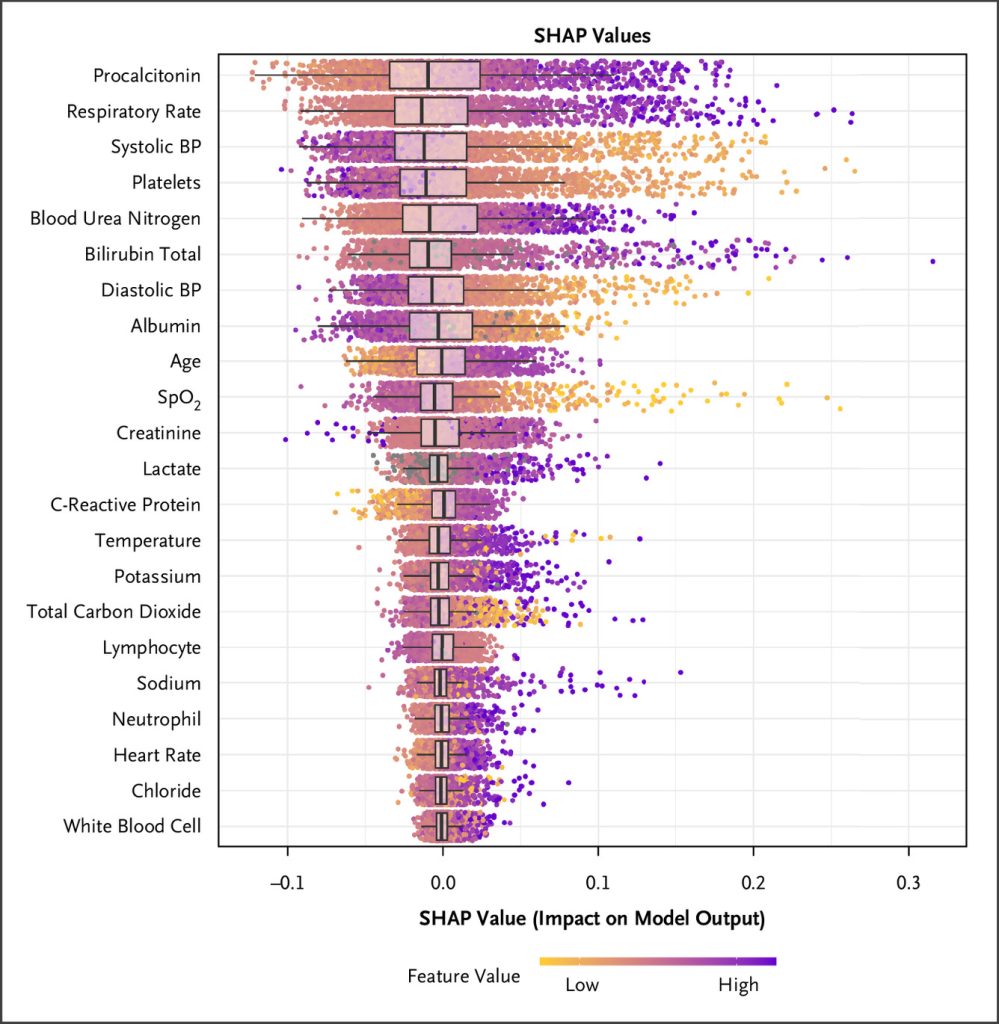

Sepsis is a critical medical condition resulting from an abnormal immune response to infection, often causing organ dysfunction and high morbidity and mortality rates. Prompt treatment, especially with antibiotics, can significantly improve outcomes. However, the varied clinical presentation of sepsis makes early detection challenging, contributing to higher mortality rates. This underscores the urgent need for reliable risk assessment tools to help clinicians identify high-risk patients quickly and accurately. While numerous tools, such as clinical methods, laboratory tests, and biomarkers, have been proposed, none have been universally adopted. Notably, no AI-based models for sepsis detection have received FDA approval for commercial use.
Researchers from NEJM AI, a division of the Massachusetts Medical Society, developed and validated the Sepsis ImmunoScore, the first FDA-authorized AI-based tool for identifying patients at risk of sepsis. Designed for integration with electronic medical records (EMRs), this machine learning-driven tool predicts the likelihood of sepsis onset or progression within 24 hours of patient evaluation. In April 2024, it received FDA marketing authorization through the de novo pathway. The study aimed to assess the Sepsis ImmunoScore’s performance in detecting sepsis (based on Sepsis-3 criteria) and its secondary outcomes, including in-hospital mortality, ICU admission, hospital stay length, mechanical ventilation, and vasopressor use.
The study conducted a prospective, multicenter observational study to develop and evaluate an ML algorithm, the Sepsis ImmunoScore, designed to identify sepsis within 24 hours and assess critical illness outcomes such as mortality and ICU admission. The study enrolled adult patients hospitalized at five U.S. hospitals between April 2017 and July 2022. Participants included those with suspected infections and lithium-heparin plasma samples collected within six hours of blood culture orders. The study population was divided into three cohorts: derivation (n=2366), internal validation (n=393), and external validation (n=698). The primary outcome was sepsis diagnosis within 24 hours using Sepsis-3 criteria, while secondary outcomes included metrics like in-hospital mortality, length of stay, ICU transfer, mechanical ventilation, and vasopressor use.
The Sepsis ImmunoScore, developed using a calibrated random forest model, utilized 22 patient-specific features, including vital signs and lab results, to predict sepsis risk. Missing data for specific parameters were handled through imputation. The algorithm was tested for accuracy using AUROC, likelihood ratios, and predictive values across risk categories, with confidence intervals reported. Sensitivity analyses distinguished between initial sepsis diagnosis and cases developing within 24 hours.
The study evaluated 3,457 patient encounters with valid Sepsis ImmunoScore results distributed across derivation (2,366 encounters), internal validation (393), and external validation cohorts (698). The participants reflected demographic and clinical characteristics typical of sepsis patients in the U.S. Sepsis rates varied by cohort: 32% in derivation, 28% in internal validation, and 22% in external validation. Patients diagnosed with sepsis had higher rates of severe illness and mortality compared to those without. The Sepsis ImmunoScore algorithm utilized 22 input parameters, including demographic data, vital signs, metabolic panel results, complete blood count, and sepsis biomarkers, such as PCT and CRP, to generate a stratified risk score. SHAP analysis highlighted PCT, respiratory rate, and systolic blood pressure as the most influential factors, with the derivation set achieving an AUC of 0.85, demonstrating robust diagnostic accuracy.
The algorithm’s risk categories effectively predicted sepsis and its secondary outcomes, such as in-hospital mortality, ICU admissions, mechanical ventilation, and vasopressor use within 24 hours. Risk stratification showed a stepwise increase in outcome severity across categories, validated by external datasets. Diagnostic and prognostic analyses indicated strong performance, with an AUC of 0.84 for diagnosing sepsis at presentation and 0.76 for predicting its development within 24 hours. These results underscore the Sepsis ImmunoScore’s ability to integrate multidimensional data for comprehensive sepsis risk assessment. Compared to existing FDA-approved diagnostic tools, which often focus on single biomarkers like PCT or leukocyte biophysical properties, the Sepsis ImmunoScore offers a broader and more predictive approach.
Check out the Paper. All credit for this research goes to the researchers of this project. Also, don’t forget to follow us on Twitter and join our Telegram Channel and LinkedIn Group. Don’t Forget to join our 60k+ ML SubReddit.
The post Sepsis ImmunoScore: The First FDA-Authorized AI Tool for Early Sepsis Detection and Risk Assessment appeared first on MarkTechPost.
Source: Read MoreÂ



 Trending: LG AI Research Releases EXAONE 3.5: Three Open-Source Bilingual Frontier AI-level Models Delivering Unmatched Instruction Following and Long Context Understanding for Global Leadership in Generative AI Excellence….
Trending: LG AI Research Releases EXAONE 3.5: Three Open-Source Bilingual Frontier AI-level Models Delivering Unmatched Instruction Following and Long Context Understanding for Global Leadership in Generative AI Excellence….
